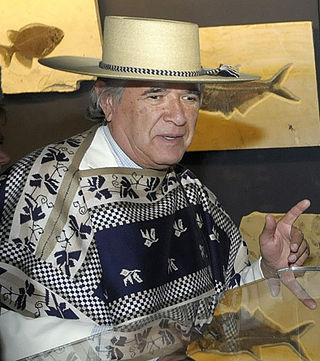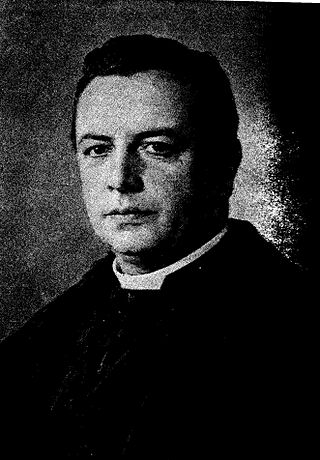Sources
- Johan Cardoen (PDF)
- CropDesign sluit miljoenen-contract met BASF Plant Science (in Dutch)
Johan Cardoen is a Belgian scientist and businessman. He is Managing Director of VIB and board member of FlandersBio. He obtained a PhD in biology at the Katholieke Universiteit Leuven (Leuven) in 1987.
Johan Cardoen has worked for CropDesign between 1999 and 2012. He has spent most of his career in agricultural biotechnology companies such as Plant Genetic Systems, Hoechst Schering AgrEvo GmbH and Aventis CropScience.

Genetic engineering, also called genetic modification or genetic manipulation, is the modification and manipulation of an organism's genes using technology. It is a set of technologies used to change the genetic makeup of cells, including the transfer of genes within and across species boundaries to produce improved or novel organisms.
The following outline is provided as an overview of and topical guide to agriculture:
Agronomy is the science and technology of producing and using plants by agriculture for food, fuel, fiber, chemicals, recreation, or land conservation. Agronomy has come to include research of plant genetics, plant physiology, meteorology, and soil science. It is the application of a combination of sciences such as biology, chemistry, economics, ecology, earth science, and genetics. Professionals of agronomy are termed agronomists.

Horticulture is the science and art of growing fruits, vegetables, flowers, or ornamental plants. Horticulture is commonly associated with the more professional and technical aspects of plant cultivation on a smaller and more controlled scale than agronomy. There are various divisions of horticulture because plants are grown for a variety of purposes. These divisions include, but are not limited to: propagation, arboriculture, landscaping, floriculture and turf maintenance. For each of these, there are various professions, aspects, tools used and associated challenges; Each requiring highly specialized skills and knowledge of the horticulturist.
Intercropping is a multiple cropping practice that involves the cultivation of two or more crops simultaneously on the same field, a form of polyculture. The most common goal of intercropping is to produce a greater yield on a given piece of land by making use of resources or ecological processes that would otherwise not be utilized by a single crop.

Floriculture is the study of the efficient production of the plants that produce showy, colorful flowers and foliage for human enjoyment in human environments. It is a commercially successful branch of horticulture and agriculture found throughout the world. Efficient production practices have been developed over the years, for the hundreds of plant taxa used in the floral industry, increasing the overall knowledge of whole plant biology. Plant breeding and selection have produced tens of thousands of new genotypes for human use. Jasmine, marigold, chrysanthemum, rose, orchid, and anthurium are flowers of commercial demand.
The photosynthetic efficiency is the fraction of light energy converted into chemical energy during photosynthesis in green plants and algae. Photosynthesis can be described by the simplified chemical reaction

VIB is a research institute located in Flanders, Belgium. It was founded by the Flemish government in 1995, and became a full-fledged institute on 1 January 1996. The main objective of VIB is to strengthen the excellence of Flemish life sciences research and to turn the results into new economic growth. VIB spends almost 80% of its budget on research activities, while almost 12% is spent on technology transfer activities and stimulating the creation of new businesses, in addition VIB spends approximately 2% on socio-economic activities. VIB is member of EU-LIFE, an alliance of leading life sciences research centres in Europe.
Staf Van Reet is a Belgian scientist and businessman. Currently he is Managing Director of the biotech company Viziphar Biosciences BVBA, and member of the Board of Directors of Janssen Pharmaceutica and the VIB. He was succeeded as Chairman of FlandersBio by Johan Cardoen.

Bioversity International is a global research-for-development organization that delivers scientific evidence, management practices and policy options to use and safeguard agricultural biodiversity to attain global food- and nutrition security, working with partners in low-income countries in different regions where agricultural biodiversity can contribute to improved nutrition, resilience, productivity and climate change adaptation. In 2019, Bioversity International joined with the International Center for Tropical Agriculture to "deliver research-based solutions that harness agricultural biodiversity and sustainably transform food systems to improve people's lives". Both institutions are members of the CGIAR, a global research partnership for a food-secure future.

Maruca vitrata is a pantropical insect pest of leguminous crops like pigeon pea, cowpea, mung bean and soybean. Its common names include the maruca pod borer, bean pod borer, soybean pod borer, mung moth, and the legume pod borer. The species was first described by Johan Christian Fabricius in 1787.
The International Society for Horticultural Science (ISHS) is the world's leading independent organization of horticultural scientists. Its aim is "to promote and encourage research and education in all branches of horticultural science and to facilitate cooperation and knowledge transfer on a global scale through its symposia and congresses, publications and scientific structure." Membership is open to all interested researchers, educators, students and horticultural industry professionals.
Cardoen may refer to:

Carlos Remigio Cardoen Cornejo is a Chilean arms dealer, metallurgical engineer, weapons scientist and agricultural businessman.

Vecauce Manor, also known as Auce Manor, is a manor house near the town of Auce in the historical region of Semigallia, in Latvia originally designed by Friedrich August Stüler for Count Johan Friedrich von Medem and constructed between 1839 and 1843. Since 1920, the building has been used for education purposes and is currently run by the Latvia University of Life Sciences and Technologies.

Plant breeding is the science of changing the traits of plants in order to produce desired characteristics. It is used to improve the quality of plant products for use by humans and animals. The goals of plant breeding are to produce crop varieties that boast unique and superior traits for a variety of applications. The most frequently addressed agricultural traits are those related to biotic and abiotic stress tolerance, grain or biomass yield, end-use quality characteristics such as taste or the concentrations of specific biological molecules and ease of processing.

Frans Alfons Ignace Maria Janssens was Catholic priest and the discoverer of crossing-over of genes during meiosis, which he called "chiasmatypie". His work was continued by the Nobel Prize winner Thomas Hunt Morgan to develop the theory of genetic linkage.
Johan Bellemans is a Belgian former Olympic sailor and physician who became known for the announcement of "discovery" of the anterolateral ligament, already discovered by French doctor Paul Segond in 1879. He discovered it along with Steven Claes in 2013, after a 134-year period of study for a missing part.
Johan Hendrik Neyts is a Belgian virologist. He is head of The Neyts-lab of Virology, Antiviral Drug and Vaccine Research, which is part of the Laboratory of Virology and Chemotherapy at the Rega Institute for Medical Research, and full professor of virology at the Faculty of Medicine of KU Leuven. During the 2019-2020 coronavirus pandemic, Neyts came to national prominence as an expert on the (re)search for antiviral drugs and vaccines against SARS-CoV-2.